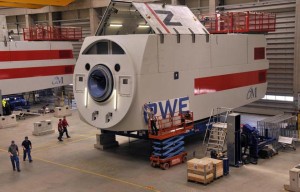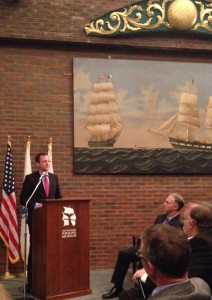We have much more to do and your continued support is needed now more than ever.
Germany’s Offshore Wind Power Leaders Cross the Atlantic to Share their Success
“We here in New Bedford consider ourselves to be dry sponges. Determined dry sponges.” – Mayor Jon Mitchell

Without minimizing their accomplishments, the three German leaders spoke with stark simplicity on how they got to where they are. Senator Martin Günthner from Bremen portrayed how offshore wind development helped his city rise from a dark era of high unemployment:
“We decided to step into the future for our own city.” That future was offshore wind – a decision which has brought Bremen 4,000 jobs. Speaking to New Bedford, Günthner encouraged, “You have the power of the sea… you can use this power to create new jobs… If we can offer our expertise, we are of course proud to be here.”
With the stage set for getting to work, Matt Morrissey, head of New Bedford’s Wind Energy Development Center, introduced a panel of leaders prepared to paint the picture of where we are, what’s taking so long, and exactly what needs to happen. Morrissey started by ensuring the crowd that “this is an industry we are very, very serious about.” Representing decades of commitment to bringing offshore wind power to American waters, the U.S. panelists underscored his sentiment and brought tangible focus to the path ahead.

Deepwater Wind CEO Jeff Grybowski offered some solace from the feeling that that fate of the industry rests on Capitol Hill, with a reminder that “individual states can do a great deal to help the industry.” Ensuring that strong, long-term power purchase agreements are in place for offshore wind farms, building offshore wind power training programs into university and community college curricula, and fostering support and investment locally – all of this can be a product of individual commitment and innovation.
A key piece of a big picture
While New Bedford commits to new energy solutions, the Environmental Protection Agency is developing regulations to cut the carbon pollution emitted by power plants, a critical step for spurring a transition to cleaner sources of electricity. Just last week, PJM Interconnection released a study confirming that the mid-Atlantic region and eastern Great Lakes could effectively draw up to 30% of their electricity from renewable sources – with offshore wind playing a significant role – and enjoy overall net economic benefits.
The right conversations are happening, and the results are clear: it is time for the U.S. to get in the offshore wind power game. 64 utility-scale wind farms in Europe could be a daunting display of just how far Europe has gone without us in the past two decades. Or they could offer a tremendous resource: motivation to push past our political obstacles. Thousands of jobs, clean air and water for wildlife and future generations, a truly diverse energy portfolio – the rewards are well worth the climb. Germany enjoys them today, and with the brilliant vision adn leadership shining in New Bedford, soon we will too.
![]() Urge your representatives on Capitol Hill to take their piece of America’s offshore wind puzzle and get it right, to pass the Incentivizing Offshore Wind Power Act and create financial stability to help this industry thrive.
Urge your representatives on Capitol Hill to take their piece of America’s offshore wind puzzle and get it right, to pass the Incentivizing Offshore Wind Power Act and create financial stability to help this industry thrive.




















